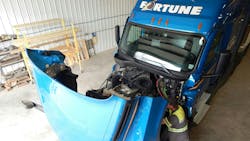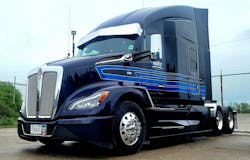Reefer fleets add to ROI with proactive maintenance
Key Highlights
- Increasing ROI for reefer fleets means minimizing downtime, which can be done through proactive maintenance
- Proactive maintenance both increases uptime and helps retain drivers for greater ROI
- HOwever, proactive maintenance comes with associated costs, which need to be carefully managed
Return on investment (ROI) is critical for any truck purchase. And maintenance often plays a large role in making sure that ROI is realized by maximizing a truck's uptime, and ultimately, its resale value later in its life. At the TCA Refrigerated meeting from July 16-18 at the Hotel Polaris in Colorado Springs, reefer fleet experts came together to discuss how to leverage predictive maintenance to increase ROI for refrigerated fleets.
For more on refrigerated trailer management:
Before delving into how reefer fleets can streamline their maintenance processes, it’s first important to know how to track your ROI. After all, if you can’t measure something, how can you know what needs to be changed and by how much? For Drew Martin, director of Leasing at Prime, Inc., tracking and managing your fleet’s ROI comes down to three main points: reducing downtime, growing vendor relationships, and having reliable warranties. Of those, the first is probably the costliest, he noted.
“[Downtime is hidden because] there’s so much more cost to downtime than just a truck being down: driver turnover, lost earnings, hotel [spending],” Martin said. “You can have the greatest warranty on a truck possible and have no repair cost. But with hours-of-service regulations out there, downtime is just a killer in the industry.”
Vendor relationships have their place in maximizing ROI, too, as how and when you can get a truck serviced, and with how much parts and diagnostic support is key to reducing its downtime. This means that fleets need to not only trust their vendors to provide them with a quality asset, but knowing that they’ll support them after the sale, too.
“Sometimes it's not so much what you buy, but where you buy it from,” Martin emphasized.
Finally, warranty plays a critical role in maximizing ROI because of how it impacts a truck’s resale value. This is especially true for some of the more complex systems on a truck, like the aftertreatment. This can be tricky, though, since OEMs and parts manufacturers tend to avoid paying for warranty work if the component isn’t broken, even if it’s showing signs that it won’t be working soon, Martin cautioned.
“Right now, if you’re buying a lot of warranty on the trucks and expecting it to be covered, it’s been a fight, because the goal of warranty is pretty much to confuse you and deny it,” he added.
This is where technology and predictive maintenance can help ease frustration for refrigerated fleets, by helping provide more information about a component that isn’t working and helping them avoid a breakdown before it happens.
Using predictive maintenance to decrease downtime
Predictive and proactive maintenance together can help increase a truck’s ROI by keeping components in fighting shape for longer. For example, Trevor Kurtz, general manager and owner of Brian Kurtz Trucking, employs proactive maintenance practices to his fleet’s belts, starters, and batteries, “a lot of it every fall before the weather sweeps in.”
This practice, especially with batteries, can increase ROI even more by allowing Brian Kurtz Trucking to reuse batteries somewhere else.
The carrier also “changes airbags religiously at four years,” Kurtz added. “There’s no option but to change them—we’ve had way too many issues with Year 4, Year 5.”
And to add to the savings, the company does a lot of its own maintenance in-house, including PEIs, dielectric greasing, and alignments. Fleet managers also check the vehicles themselves when they’re fresh from a dealership.
“I don’t think we’ve been delivered a truck or trailer in the last three years that hasn’t been out of alignment,” Kurz commented. “Our standard practice now for our service is guys spend two hours on the trailer with a descaler, and they clean all the towings.”
Additionally, Kurtz’s techs inspect all the rotors, look for rust, and check the ABS plugs for corrosion. They also add longer ABS cables to provide fewer entry points for rust. Meanwhile, Prime’s Martin also has his technicians proactively replace starters and alternators.
“It’s been a long road, but it’s stopped a lot of on-the-road stuff,” Kurtz affirmed on their proactive maintenance practices. “It really has helped.”
The cost of proactive maintenance
Predictive maintenance helps increase ROI by avoiding breakdowns before they happen—as long as fleets abide by the warnings they get. If they don’t, they both reduce the ROI for the truck and may be saddled with new costs they weren’t anticipating.
“[A fleet’s mindset can be] we’ll do one more load, one more load, and then the tire blows,” said Perry Olson, CEO and owner of Fortune Transportation. “Now all of a sudden, you’ve got a perpetual problem that was a predicted problem.”
And this can be especially true when a fleet finds that a problem on one truck is mirrored across others, which suffer the same result when a fleet isn’t sure of the root cause.
“We had a problem, we just didn’t figure it out fast enough,” Olson said. “You’ve got to get on top of the things that need to be done when they need to be done and then stick to your guns and get it done.”
And this not only results in repair costs for the fleet, but HR-related ones, too, when a driver gets fed up when his truck breaks down for the third time in two months.
“Driver satisfaction is a big part of downtime,” Kurtz added. After all, even if he has more leeway on when he gets a truck fixed because he runs a wide variety of ranges, “that driver is going to be upset, especially being LTL.”
But the elephant in the trailer is that while proactive maintenance can help reduce a fleet’s costs in roadside downtime, it does take some investment. But especially for reefers going on long-haul trips with fewer trips to the shop in between, the investment is worth it—even if the fleet needs to be careful on managing when those shop stops happen.
“Those are decisions that need to be made, and they need to be managed,” Olson stated. “And there’s sometimes a little creativity to that.”
But these are decisions that even a smaller fleet can make. Kutz’s brother runs a shop that the fleet works with, and between him and Kurtz’s CFO, he keeps a careful eye on when they can afford the parts they’ll need. Sometimes this means buying parts before they’ll need them, but Kurtz noted that when opportunities arise, he tends to take them.
“We watch our cash flow, and then communicate with her on a regular basis,” Kurtz explained. “If there’s a deal out there and we can afford to swing it, we’ll grab them.”
Making maintenance more affordable
So if proactive maintenance presents such a strong opportunity for fleets, even with its cost, what can fleets do to leverage the benefits while reducing their expenses and increasing overall ROI?
For Prime, managers remain flexible and holistically analyze their fleet and maintenance data.
“One thing you do today might not be right tomorrow,” Martin advised. “So it’s really just staying on that analysis, of [looking for] savings.”
That includes monitoring expense changes over time and based on geography.
“It's kind of hard to wade through sometimes,” Martin admitted. “But data doesn’t lie.”
But to save time and money, reefer fleets can consider becoming single-brand operators, like Olson’s Fortune Transportation. He called the move a “necessity” as much as anything else.
“We’re in the middle of nowhere with corn fields and deserts, so in some cases, it’s 200 miles to the closest part,” Olson explained. Which is why using the same brands and trucks can be so helpful, because it allows the company to train their technicians the same way across every shop, and they see the same problems and can help each other out. Plus, that allows all the parts inventory to carry the same items, allowing for more buying in bulk as well as adaptation on the fly.
Syncing your service intervals can help here, too.
“We also want to pair stuff together, so if we’re in the shop, we’d rather do two or three things than have to come back multiple times with it,” Martin added. And asking for more help never goes awry, either.
“We really pushed a lot of the OEMs to try to help with that maintenance cost,” Martin said.
By applying proactive maintenance along with a careful eye toward expenses, fleet managers can increase the ROI for their trucks by minimizing costs and keeping trucks on the road.
About the Author

Alex Keenan
Alex Keenan is an Associate Editor for Fleet Maintenance magazine. She has written on a variety of topics for the past several years and recently joined the transportation industry, reviewing content covering technician challenges and breaking industry news. She holds a bachelor's degree in English from Colorado State University in Fort Collins, Colorado.


![“[A fleet’s mindset can be] we’ll do one more load, one more load, and then the tire blows,” said Perry Olson, CEO and owner of Fortune Transportation Company. “Now all of a sudden, you’ve got a perpetual problem that was a predicted problem.” “[A fleet’s mindset can be] we’ll do one more load, one more load, and then the tire blows,” said Perry Olson, CEO and owner of Fortune Transportation Company. “Now all of a sudden, you’ve got a perpetual problem that was a predicted problem.”](https://img.fleetmaintenance.com/files/base/ebm/fm/image/2025/08/689103db5c42d5950d0cdb66-6890cd54383b84c588c760f320201021_093758.png?auto=format,compress&fit=max&q=45&w=250&width=250)
